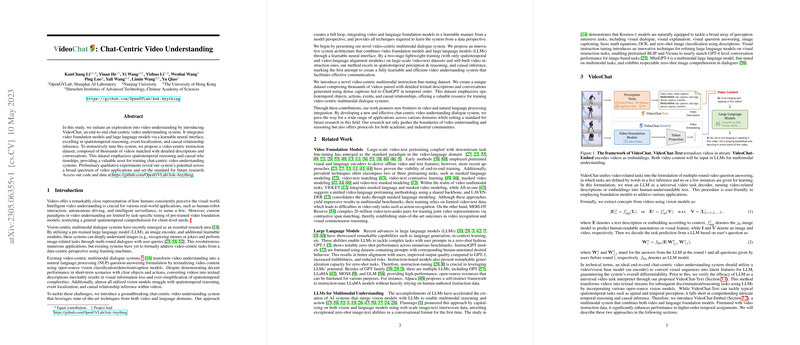Chat-Centric Video Understanding: A Technical Overview of VideoChat
The paper presents a technical exploration into the development of an end-to-end chat-centric video understanding system named VideoChat. This system integrates video foundation models with LLMs through a learnable neural interface, focusing on spatiotemporal reasoning, event localization, and causal relationship inference. The work is rooted in the broader research area of vision-centric multimodal dialogue systems, bringing video processing into the conversational AI space.
System Architecture and Dataset Construction
VideoChat is structured into two primary methodologies: VideoChat-Text and VideoChat-Embed. The former utilizes multiple vision models to convert video content into a textual form, which is subsequently processed by a pretrained LLM for task execution. This approach, while effective for basic spatial perception and actions, faces limitations in handling higher-order temporal reasoning and causal inference.
VideoChat-Embed advances this functionality by integrating state-of-the-art techniques from both video and language domains. It relies on a Video-Language Token Interface (VLTF) to align video content with LLMs efficiently. This is particularly crucial for spatiotemporal perception, where the complexity of interactions within the video medium is non-trivial to encapsulate fully.
A novel dataset supports the training of this system, emphasizing video-centric instruction. Comprised of thousands of videos with detailed descriptions and dialogues, this dataset is pivotal for training the chat-centric video understanding model, focusing on capturing spatiotemporal objects, actions, events, and their causal relations.
Experimental Results and Implications
Preliminary qualitative experiments showcase VideoChat's adeptness in handling a wide spectrum of video applications. The system demonstrates the capability to not only engage in detailed spatial perception but also execute temporal reasoning tasks and causal inference in real-time conversations with users. These abilities suggest a potential repositioning of how video data can be utilized in AI-driven dialogues.
Despite these advancements, the paper acknowledges limitations in processing long-duration videos and the comprehensive understanding required for complex temporal and causal reasoning. These remain avenues for further exploration.
Theoretical and Practical Implications
From a theoretical perspective, the integration of video and language foundation models with LLMs advances our understanding of multimodal learning systems, especially the challenge of bridging temporally rich video data with sequential LLMs. Practically, these insights are valuable for applications across various domains, including human-robot interaction, autonomous systems, and advanced surveillance technologies.
The research sets a foundation for future work in video understanding and reasoning, suggesting the necessity for scaling video foundation models and developing robust multimodal training/data benchmarks. As AI applications increasingly demand real-time, nuanced understanding of multimedia content, systems like VideoChat highlight the trajectory towards more integrated, capable AI frameworks capable of such tasks.
The paper serves as an important step in evolving video understanding systems, emphasizing the role of integrated modalities in enriching AI's interpretive and interactive potential.
